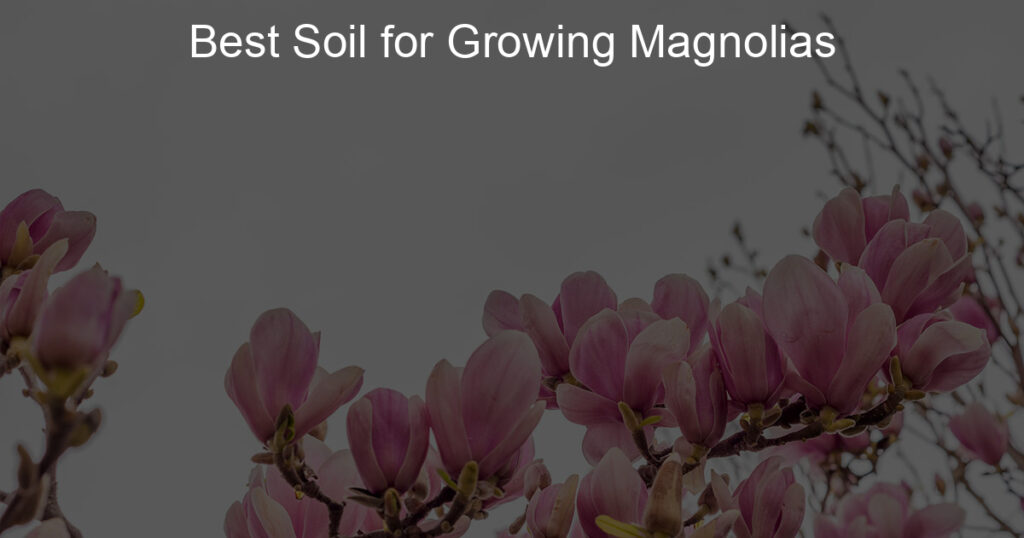If you want to grow magnolias, you need to start with the right soil. But what is the best soil for growing magnolias? Here’s a look at what you need to know to get started.
The best soil for magnolia trees
For magnolia trees to thrive, they need well-draining soils, with a pH balance between 4.0 and 6.0. Magnolias prefer sandy, loamy soils with plenty of organic matter and good aeration for their root systems. While magnolias can tolerate some acidic soil, too much can lead to nutrient deficiencies and poor growth.
Pay special attention to the drainage when planting a magnolia tree; if the soil is too wet or soggy during the winter months, its roots may rot due to a lack of oxygen in the soil. Incorporate compost or peat moss into the dirt surrounding your magnolia tree to help it retain moisture during dry spells while keeping its feet out of standing water.
With the right conditions and care, these beautiful trees will bring visual interest and majestic elegance to your garden for many years to come!
Do magnolias need ericaceous soil?
Magnolias are well known for their beauty, with large fragrant flowers that lend grace to any garden. But before planting a magnolia tree, one must consider the soil requirements.
Magnolias need acidic or neutral soil with a pH between 6.5 and 7 to thrive. In many cases, ericaceous soil is an ideal medium to grow magnolias as it naturally contains peat moss, which helps condition the soil and encourages acidity.
Be sure to test your soil before planting any trees and adjust accordingly — adding sulfur will make the soil more acidic, for example. Knowing the proper care for your soil can make all the difference in how your magnolias will bloom season after season.
Is Epsom salt good for magnolia trees?
Epsom salt can have a surprisingly positive effect on magnolia trees, though it is often underestimated as a fertilizer. The key benefit of Epsom salt for magnolia trees is its use as a source of magnesium. Magnesium is vital for parts of the plant including flower production and overall growth, and when a tree lacks it, its health can suffer greatly.
Applying small amounts of Epsom salt around the base and roots to provide your tree with this essential nutrient can help prevent the headaches which come with magnesium deficiencies and work wonders for your magnolia in terms of improved root health, stem strength, foliage, and flowering. With some regular applications of Epsom salt over time you could have blooms you can be proud of.
Planting a magnolia tree in clay soil
Planting a magnolia tree in clay soil can be a challenge, but also extremely rewarding. Clay soil is known for its compact nature, making it difficult to break apart. However, this dense soil serves as an excellent anchor for the magnolia’s strong roots. Some amendments may need to be done before planting your magnolia including adding some organic matter and soil conditioner to help with drainage.
When planting your magnolia into the clay soil, dig an area large enough for the roots to spread out without tension. This creates an environment where the roots can stretch out, helping to ensure your magnolia will thrive in its natural environment.
Taking advantage of this simple step with clay soil is worth all the effort – soon, you’ll have a majestic magnolia tree with deep roots and beautiful stems full of unique flowers!
How do I make my soil more acidic for magnolias?
When it comes to acidifying soil for magnolias, there are several effective methods. First, adding an acidic fertilizer, such as ammonium sulfate or elemental sulfur, is one of the more common ways to make the soil more acidic. Alternatively, applying ground elemental sulfur in granular form can help adjust the pH level as well. Another great option for lowering the soil’s pH value is adding compost made from organic materials like straw and dried grass – this will also promote aeration and microbial activity. Finally, if you want a chemical-free approach, consider using aluminum sulfate or citric acid and simply following the directions on the product packaging for the best and safer results.
By following any of these suggestions, you can easily create a healthy growing environment for your magnolias.
The Final Word: Best Soil for Growing Magnolias
To sum it up, soil with a pH range of 6-6.5 and good drainage is the best option for growing magnolias as they don’t prefer an overly alkaline or acidic environment. Along with ensuring that the soil has good drainage, consider adding some organic matter to your garden such as compost or manure mixture to provide additional moisture and nutrition.
With proper attention and care, magnolias can thrive even in somewhat poor soil conditions. If your soil falls on the low side of pH levels, however, you may have to opt for raised beds or create mixed beds of topsoil and sand, a feat easily achievable with proper guidance.
Finally, keep in mind that magnolia trees require attention every season so make sure you’re keeping track of their fertilizer needs to achieve a strong root system and foliage all year round. Magnolias are truly magnificent plants that deserve plenty of love and care to ensure healthy growth.














